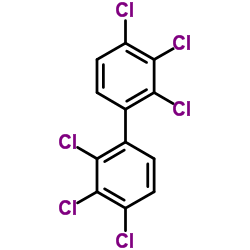Stimulatory effects of a microbially dechlorinated polychlorinated biphenyl (PCB) mixture on rat uterine contraction in vitro.
Taeko Tsuneta, Rita Loch-Caruso, John F Quensen, Stephen A Boyd, Mona Hanna, Carmen Grindatti
Index: Environ. Res. 107(2) , 185-93, (2008)
Full Text: HTML
Abstract
Microbially mediated reductive dechlorination has been advocated as the first part of a two-stage (anaerobic/aerobic) biotreatment process for polychlorinated biphenyls (PCBs) in sediments, and is generally viewed as a detoxication process. However, previous studies suggest that microbial dechlorination increases the ability to stimulate uterine contractions compared with the original PCB mixtures. Here, we investigate the composition and uterotonic activity of the commercial PCB mixture Aroclor 1260 before and after incubation with microorganisms eluted from PCB-contaminated sediment of the Hudson River. Incubation with microorganisms resulted in a partially dechlorinated mixture (HR1260) dominated by ortho-substituted PCBs with four or fewer chlorines per biphenyl. Aroclor 1260 that had not been incubated with microorganisms had no significant effect on contraction frequency of rat uterine strips (gestation day 10) in vitro, whereas HR1260 dramatically increased contraction frequency to 718+/-134% of the basal rate at a total PCB concentration of 70 microM (p<0.05). The microbial dechlorination increased 2,2',4,4'-tetrachlorobiphenyl and one or more of four congeners that co-eluted during chromatography (2,3,3',5-tetrachlorobiphenyl, 2,3',4,5-tetrachlorobiphenyl, 2,2',4,4',6-pentachlorobiphenyl and 2,2',4,5',6-pentachlorobiphenyl) to 24 and 8 mol%, respectively. However, the uterotonic activities of the latter congeners were modest when evaluated either solely or in a reconstituted mixture and could not fully account for the uterotonic activity of HR1260. Nonetheless, the relative abundance of congeners with three or fewer chlorines increased to 14 mol% as a group in HR1260, suggesting that these congeners collectively contribute to the uterotonic activity even though the abundance of any one congener in this group was less than 5 mol%.
Related Compounds
| Structure | Name/CAS No. | Molecular Formula | Articles |
|---|---|---|---|
 |
PCB No(Aroclor 1260)158 solution
CAS:11096-82-5 |
C12H4Cl6 |
|
Extensive biodegradation of polychlorinated biphenyls in Aro...
2008-01-01 [Chemosphere 73(1) , 126-32, (2008)] |
|
Use of a polar ionic liquid as second column for the compreh...
2010-09-10 [J. Chromatogr. A. 1217(37) , 5859-67, (2010)] |
|
Transcriptome-wide gene expression in a rat model of attenti...
2011-12-01 [Am. J. Med. Genet. B. Neuropsychiatr. Genet. 156B(8) , 898-912, (2011)] |
|
Parallelism and dissociation in the actions of an Aroclor 12...
2003-12-15 [Toxicology 194(1-2) , 65-75, (2003)] |
|
Dermal absorption in rhesus monkeys of polychlorinated biphe...
2002-06-01 [Regul Toxicol Pharmacol 35(3) , 289-95, (2002)] |